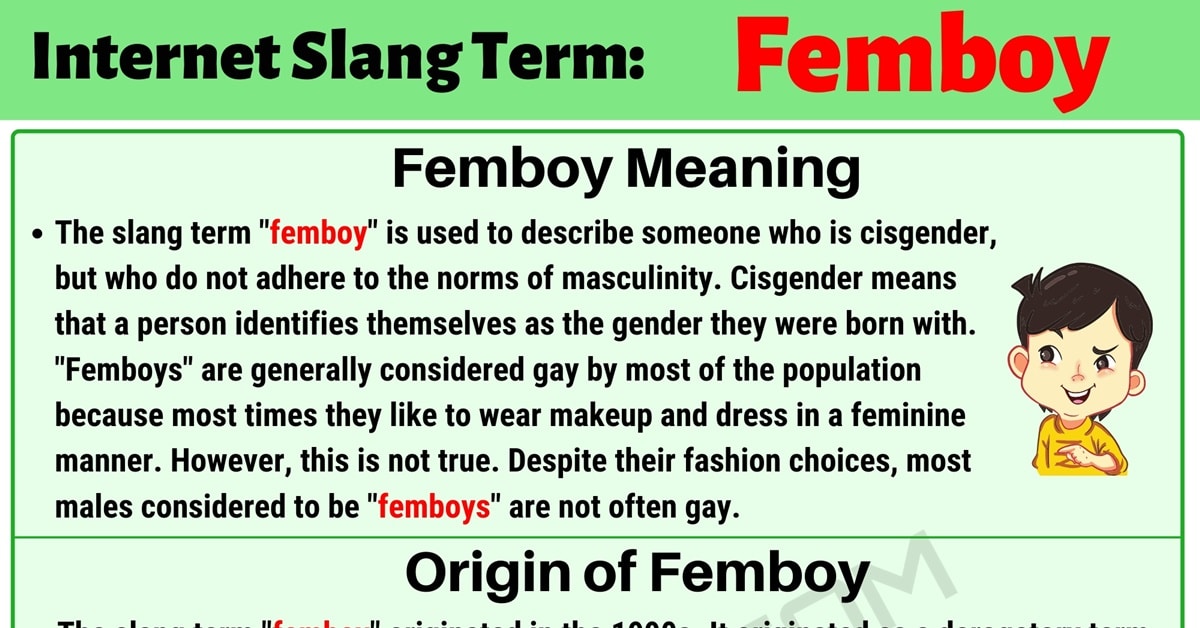The term "femboy" has recently gained traction in popular culture, particularly among younger generations. This unique expression of gender identity blends traditionally masculine and feminine traits, leading to a vibrant and diverse representation of self. But what does it truly mean to be a femboy? In this article, we will explore the femboy meaning, its origins, and how it fits into the broader spectrum of gender identity.
Femboys often embrace a style that incorporates elements of femininity, such as clothing, grooming, and mannerisms, while still identifying as male. This duality challenges conventional norms and allows individuals to express themselves authentically. The femboy culture has developed its own community, with social media platforms serving as a space for individuals to connect, share experiences, and support one another in their journey of self-discovery.
As society progresses towards a more inclusive understanding of gender, the femboy meaning becomes increasingly relevant. It invites us to question traditional gender roles and encourages a deeper appreciation for the diverse ways individuals choose to express their identities. Let’s delve further into the femboy phenomenon, exploring its history, cultural significance, and the questions that surround this intriguing aspect of gender identity.
What is the Femboy Meaning?
The femboy meaning can be best understood as a blend of masculine and feminine characteristics, typically associated with individuals who identify as male but express themselves in a way that is more aligned with femininity. This can include fashion choices, behavior, and interests that deviate from traditional male stereotypes. Importantly, being a femboy is not about changing one's biological sex; rather, it is about embracing a fluidity of gender expression.
How Did the Femboy Concept Emerge?
The emergence of the femboy concept can be traced back to various cultural and societal shifts. Historically, gender roles have been rigid, but over time, movements advocating for gender equality and LGBTQ+ rights have allowed for a more nuanced understanding of gender. The femboy identity has been particularly popularized through anime and manga culture, where male characters often exhibit androgynous traits.
What Are Common Traits of Femboys?
Femboys can exhibit a wide range of traits and characteristics, including:
- Fashion: Femboys often wear clothing that is considered feminine, such as skirts, dresses, or accessories traditionally associated with women.
- Grooming: Many femboys take pride in their grooming, which may include makeup, nail polish, and hairstyles that break away from traditional masculine norms.
- Mannerisms: Femboys may adopt mannerisms or behaviors that are typically viewed as feminine, such as softer speech or more expressive body language.
- Interests: Femboys might gravitate towards hobbies and interests that are stereotypically feminine, like fashion or beauty, while still enjoying traditionally masculine activities.
Who Are Some Notable Femboys in Popular Culture?
Several public figures and celebrities have openly embraced the femboy identity, paving the way for greater acceptance and visibility. Their influence has played a significant role in shaping perceptions of gender expression in contemporary society.
Biography of a Famous Femboy: Lil Nas X
| Name | Lil Nas X |
|---|---|
| Born | April 9, 1999 |
| Birthplace | Lithia Springs, Georgia, USA |
| Notable Works | “Old Town Road,” “Montero (Call Me By Your Name)” |
| Gender Identity | Identifies as a gay man and embraces femboy aesthetics |
Lil Nas X is a prominent figure in the music industry who has openly expressed his identity as a femboy. Known for his hit single "Old Town Road," he has used his platform to challenge traditional gender norms and promote self-acceptance. His bold fashion choices, often featuring vibrant colors and androgynous silhouettes, have made him a role model for many young people navigating their identities.
What Impact Do Femboys Have on Society?
The visibility of femboys in popular culture has a profound impact on societal attitudes towards gender expression. By challenging stereotypes and promoting diversity, femboys encourage conversations about gender fluidity and acceptance. Their presence helps to normalize non-traditional expressions of masculinity and femininity, fostering a more inclusive environment for everyone.
How Can One Embrace the Femboy Identity?
For those interested in exploring the femboy meaning and identity, here are some tips to embrace this unique expression:
- Be Authentic: Embrace your true self and express your individuality without fear of judgment.
- Experiment with Fashion: Try incorporating feminine clothing and accessories into your wardrobe to see what resonates with you.
- Connect with Community: Seek out online forums or local groups where you can connect with others who share similar experiences.
- Educate Yourself: Learn about gender identity and expression to better understand the nuances of the femboy culture.
What Challenges Do Femboys Face?
Despite the growing acceptance of femboys, many still face challenges in their daily lives, including:
- Stigma: Femboys may encounter negative stereotypes and discrimination from those who uphold traditional gender norms.
- Internal Conflict: Some individuals may struggle with accepting their identity due to societal pressures.
- Bullying: Femboys can be targets of bullying and harassment, particularly in school or online settings.
What Resources Are Available for Femboys?
There are numerous resources available to support femboys and individuals exploring their gender identity, including:
- Online Communities: Platforms like Reddit, Tumblr, and Instagram have dedicated spaces for femboys to connect and share their experiences.
- Support Groups: Local LGBTQ+ organizations often provide support groups and resources for individuals exploring their gender identity.
- Educational Materials: Books, articles, and documentaries about gender fluidity and expression can offer valuable insights and support.
In conclusion, the femboy meaning encapsulates a rich and complex intersection of gender identity and self-expression. Through understanding and acceptance, we can create a society that celebrates the diverse ways individuals choose to express themselves, paving the way for a more inclusive future.




